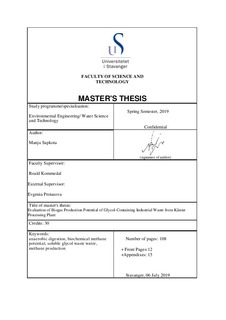| dc.contributor.advisor | Kommedal, Roald | |
| dc.contributor.advisor | Protasova, Evgenia | |
| dc.contributor.author | Sapkota, Manju | |
| dc.date.accessioned | 2019-10-22T10:59:44Z | |
| dc.date.available | 2019-10-22T10:59:44Z | |
| dc.date.issued | 2019-07-06 | |
| dc.identifier.uri | http://hdl.handle.net/11250/2623688 | |
| dc.description | Master's thesis in Environmental engineering | nb_NO |
| dc.description.abstract | This research has been carried out to investigate the potential for methane gas production from untreated glycol containing industrial waste water from Kåstrø gas refinery, Tysvær Norway. Biogas methane potential (BMP) has been tested using a batch system (AMPTS II) at 350C, whereas operating condition and inhibition has analyzed using Continuous Stirrer Tank Reactors (CSTR) at 20-250C. The goal of this research is to investigate the main limiting factors for anaerobic digestion (AD) for the particular type of industrial organic waste. Saline waste water gave 50% of BMP with 0.50 ± 9 g COD/ g COD of specific methane yield (SMY) and degradation time was 3 days. 20% BMP was resulted with SMY - 0.22 g COD/g COD and degradation time was 5 days from not-saline waste water. From the CFSTR system, SMY were 0.45 g COD/g COD and 0.20 g COD/g COD for saline and not-saline waste water respectively. Optimal COD loading in 1000 mL CFSTR were 40 gCOD/d and 26 g COD/d for saline and not-saline waste water. About 90% COD mass balance was achieved in RI containing saline waste water with constant yield in 18 days but RII containing not-saline waste water achieved only 19% COD mass balance in 26 days. The experimentally produced methane is lower than the expected methane production. The cause of inhibition in this AD process either by unbiodegradable COD or other long chain hydrocarbon is unknow. The experiment on anaerobic treatment of highly concentrated glycol containing waste need the pretreatment before digestion. The failure in the system concluded that VFA causes the pH reduction and as a result - the shutdown of reactor. Both batch and CFSTR system gives the close values for SMY, so batch reactor is best choice for anaerobic treatment of this waste water which will reduce both economic and operational costs. | nb_NO |
| dc.language.iso | eng | nb_NO |
| dc.publisher | University of Stavanger, Norway | nb_NO |
| dc.relation.ispartofseries | Masteroppgave/UIS-TN-IKBM/2019; | |
| dc.subject | teknisk miljøvern | nb_NO |
| dc.subject | miljøteknologi | nb_NO |
| dc.subject | vann | nb_NO |
| dc.subject | anaerobic digestion | nb_NO |
| dc.title | Evaluation of Biogas Production Potential of Glycol-Containing Industrial Waste from Kårstø Processing Plant | nb_NO |
| dc.type | Master thesis | nb_NO |
| dc.subject.nsi | VDP::Technology: 500::Environmental engineering: 610 | nb_NO |
